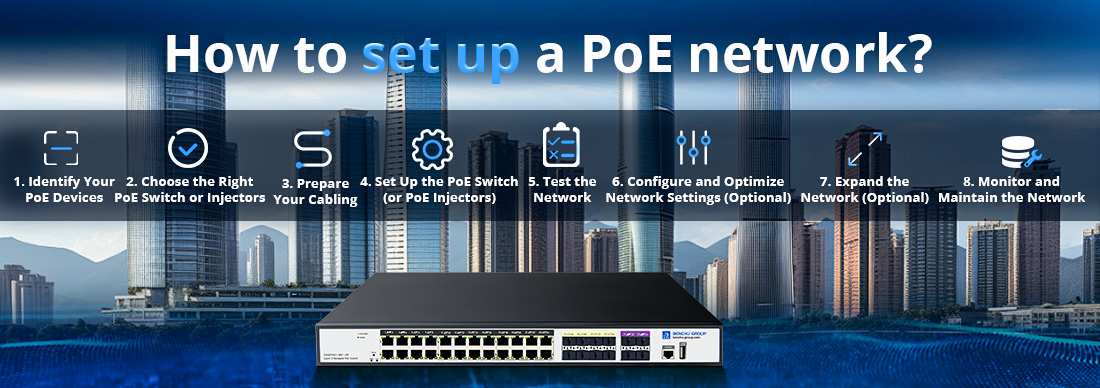
Setting up a PoE (Power over Ethernet) network allows you to deliver both power and data to devices such as IP cameras, VoIP phones, and wireless access points using a single Ethernet cable. The process of setting up a PoE network is relatively straightforward, especially with the right equipment and proper planning. Here’s a step-by-step guide to help you get started:
Step-by-Step Guide to Setting Up a PoE Network:
1. Identify Your PoE Devices
Determine which devices on your network need PoE, such as:
--- IP Cameras (security cameras)
--- VoIP Phones
--- Wireless Access Points
--- IoT Sensors or other PoE-enabled devices
Check the power requirements for these devices (standard PoE or higher power PoE+ or PoE++). Most VoIP phones and IP cameras use standard IEEE 802.3af PoE (up to 15.4W per port), while devices like PTZ cameras or wireless access points may need PoE+ (802.3at, up to 30W per port) or PoE++ (802.3bt, up to 60W or 100W per port).
2. Choose the Right PoE Switch or Injectors
Option 1: PoE Switch
A PoE switch provides both data and power to PoE-enabled devices. Select a switch based on the number of devices and the total power budget needed.
--- Managed PoE Switch: Ideal for large networks where you need remote control, monitoring, and configuration of devices.
--- Unmanaged PoE Switch: Best for smaller setups or simpler networks where no advanced configuration is needed.
PoE Standards:
--- PoE (IEEE 802.3af): Provides up to 15.4W per port, sufficient for most VoIP phones and basic IP cameras.
--- PoE+ (IEEE 802.3at): Provides up to 30W per port, suitable for more power-hungry devices like high-resolution cameras.
--- PoE++ (IEEE 802.3bt): Can provide up to 60W or 100W per port for advanced devices, such as lighting systems or high-power cameras.
Option 2: PoE Injectors
--- If you already have a non-PoE switch and don’t want to replace it, you can use PoE injectors. These devices “inject” power into the Ethernet cable going to your PoE devices.
--- PoE injectors are ideal for small setups or where only a few devices need PoE power.
3. Prepare Your Cabling
Use Cat5e, Cat6, or Cat6a Ethernet cables, which are commonly used for PoE networks. These cables can carry both power and data over longer distances, up to 100 meters (328 feet).
--- Cat6a is recommended for PoE++ devices requiring higher power or longer cable runs to ensure minimal power loss.
Ensure you have enough cable length to connect each PoE device to the switch or injector.
4. Set Up the PoE Switch (or PoE Injectors)
PoE Switch Setup:
--- Unbox and Connect the PoE switch to your existing network by plugging it into your router or core network switch.
--- Power On the PoE Switch by connecting it to an electrical outlet.
Connect Your Devices:
--- Plug Ethernet cables into the PoE-enabled ports of the switch.
--- Run the cables to each PoE device (e.g., IP cameras, VoIP phones, or access points), plugging them into the device’s Ethernet port.
--- Managed Switch Setup (optional): If you are using a managed switch, log into the switch’s web interface and configure settings such as VLANs, QoS (Quality of Service), and power management for each device.
PoE Injector Setup:
--- Connect the injector’s data input port to your existing non-PoE switch using an Ethernet cable.
--- Connect the PoE output port on the injector to the PoE device using another Ethernet cable.
--- Power the injector by plugging it into an electrical outlet.
5. Test the Network
Power On All Devices: Once connected, your PoE-enabled devices should receive both power and data from the switch or injector.
Verify Device Functionality: Check that each device (e.g., VoIP phone, camera, or access point) is receiving power and transmitting data properly.
Check Power Distribution: On a managed switch, you can monitor the power usage of each port to ensure that devices are receiving the correct amount of power. If your switch has a PoE budget (maximum total power it can deliver), monitor the overall power consumption to avoid overloading the switch.
6. Configure and Optimize Network Settings (Optional)
For Managed PoE Switches:
--- VLAN Setup: Create separate VLANs (Virtual LANs) for devices like VoIP phones or IP cameras to isolate traffic and improve security.
--- Quality of Service (QoS): Configure QoS to prioritize traffic for critical applications like VoIP calls or video streams. This ensures high-quality communication without interruptions.
--- PoE Port Management: Adjust power settings for each PoE port, especially if some devices require more power than others.
--- Remote Monitoring: Many managed PoE switches allow you to remotely monitor the status and power usage of connected devices via a web interface or network management software.
7. Expand the Network (Optional)
--- As your network grows, you can add more PoE switches or PoE injectors to power additional devices. PoE networks are scalable and flexible, making it easy to add more devices without complex wiring.
--- For large networks, you may consider deploying PoE extenders to increase the distance of your Ethernet cables beyond the 100-meter limit.
8. Monitor and Maintain the Network
--- Periodically monitor the power consumption of your PoE devices and ensure the switch's power budget is not exceeded.
--- If using a managed PoE switch, regularly check logs and alerts for any potential issues with power delivery or network performance.
--- Perform routine maintenance to ensure all Ethernet cables and connections are secure, especially in areas with high foot traffic or outdoor installations.
Conclusion:
Setting up a PoE network is a cost-effective and efficient way to power and connect devices like IP phones, cameras, and access points. By choosing the right PoE switch or injector, using proper Ethernet cabling, and optimizing network settings, you can build a scalable, flexible network that reduces installation costs and improves device management.